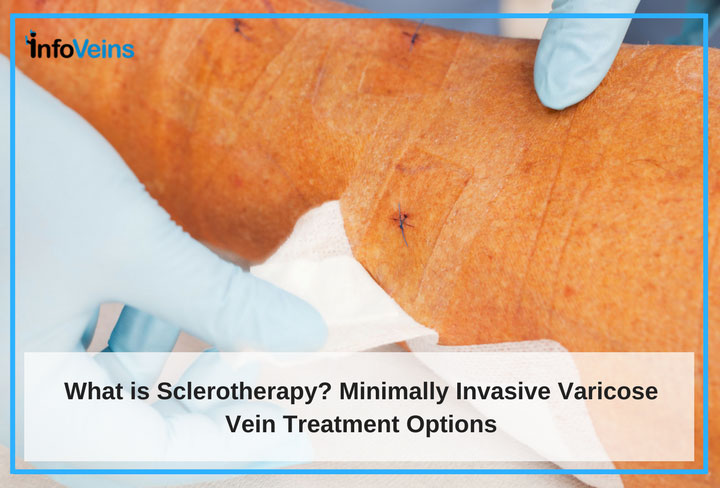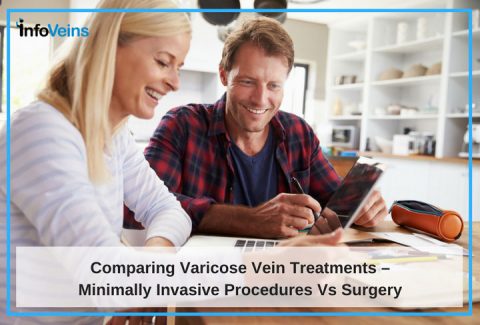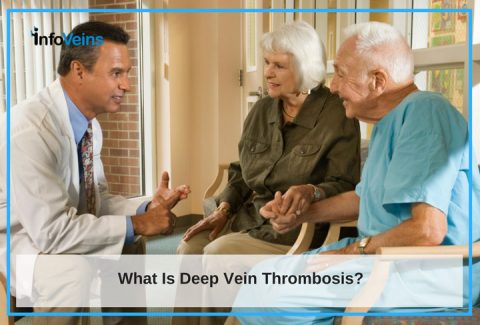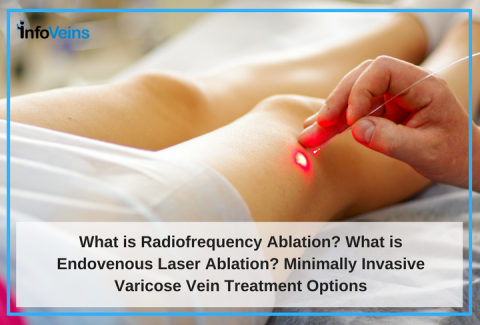
Are you contemplating treatment for your varicose veins? If you have bulging, blue veins on your legs, or if you have symptoms other than cosmetic issues, it’s important that you know and understand all of your options for treatment.
Options are a good thing, especially when it comes to medical procedures, and with varicose veins, you actually have a couple of treatment options to consider. Surgery is one option and has been around for a long time. But did you know that you may not need surgery? Despite the common misperception that surgery is the only way to treat varicose veins, there are, in fact, minimally invasive options that you may want to starting looking into. Some of the minimally invasive alternatives to surgery include: sclerotherapy, endovenous ablation and microphlebectomy. Let’s start by looking in depth at sclerotherapy.
What Are Varicose Veins?
Leaky, or incompetent one-way valves in your veins and weak vein walls are thought to be the cause of varicose veins. Blood is unable to effectively flow back to the heart, instead it remains in the veins, typically in the legs.i As blood builds up in the legs veins, the veins expand. Not everyone with varicose veins needs treatment, but if you have any of the symptoms below, you may be a candidate. Symptoms that may warrant treatment include:
- Leg discomfort
- Swelling
- Itching
- A burning or throbbing sensation
- Thickening of the skin
- Ulcers or non-healing sores
- Previous blood clots
- Problems with bleeding
Varicose Vein Treatment Options – What You Need to Know
Before you have surgery, sclerotherapy or any other minimally invasive varicose vein treatment, you may want to first try lifestyle changes. Lifestyle changes are changes you can make to how you’re living your life, and generally don’t need medical intervention. These can include losing excess weight, exercising, leg elevation and wearing compression stockings. Many insurance plans require that you try these conservative treatments first before they will consider covering more aggressive options.
RELATED: The Top 9 Varicose Vein Risk Factors
What is Sclerotherapy?
Sclerotherapy is a minimally invasive treatment for varicose veins and spider veins. During the procedure, a sclerosing agent is injected into the vein causing the vein to scar. This causes the vein to close off, and it eventually disappears. Sclerotherapy is typically used for treating the cosmetic appearance of spider veins. Spider veins are a smaller version of a varicose vein, and treatment is purely cosmetic. These small webs or branches of blue or red lines do not bulge and do not cause symptoms. While largely effective for spider veins, sclerotherapy can help the symptoms of small varicose veins as well.
The Procedure
Sclerotherapy is usually performed outside of the hospital, typically in a doctor’s office in an outpatient setting. Before the procedure you should discuss your medical history, including medications, herbal supplements and allergies, with your doctor.
On the day of your treatment, do not put lotion on your legs and wear loose comfortable clothing. When ready, the doctor will begin the procedure.
- Using a very fine needle, the sclerosing agent is injected directly into the vein
- You may feel the prick of the needle or a slight burning sensation
- Multiple veins can be treated in one session
- The procedure usually takes 30-45 minutesii
You can return to your usual activities right away, but you will need to wear compression stockings immediately after treatment.
Sclerotherapy Benefits
Sclerotherapy is effective for the cosmetic treatment of spider veins and symptomatic treatment of small varicose veins. It is successful at least 80% of the time.iii It usually takes several weeks for the veins to fade, but in some cases, it can take up to a year.iv
Risks of Sclerotherapy
Any medical procedure comes with some risk. Here are the common risks associated with sclerotherapy:
- The treatment may not be completely effective, and additional treatment may be needed
- As with any medical procedure, there is an increased risk of infection
- New small red blood vessels, called telangiectasias, can appear in the treated areaii,iii,v
While rarer, the following are also potential side effects that have been known to happen after sclerotherapy:
- Allergic reactions to the sclerosing agent
- Permanent scarring
- Temporary visual problems
- Headaches or migraines
- Deep vein thrombosis, or a blood clot in the deep vein that needs urgent medical treatmentii,v
Who Should Not Have Sclerotherapy?
Sclerotherapy is not an option for everyone. You should not have sclerotherapy if you:
- Are pregnant
- Have had a baby within the last 3 months
- Are breastfeeding
- Are immobile and do not get out of bed
- Have large varicose veins
- Have a blood clot or a history of blood clotsii
As a minimally invasive treatment that can be performed in a doctor’s office, sclerotherapy is very appealing to many patients. But sclerotherapy does not work for all types of veins. If you want to know more about the possible benefits of sclerotherapy for your varicose veins, find an Interventional Radiologist near you today. If you have larger varicose veins, remember there are other minimally invasive treatment options you can discuss with your doctor as well.
Sources:
iMayo Clinic. Varicose Veins Overview. http://www.mayoclinic.org/diseases-conditions/varicose-veins/home/ovc-20178078 (updated 1/22/2016, accessed 11/30/2016)
iiRadiologyInfo.org, Sclerotherapy of Varicose Veins and Spider Veins. http://www.radiologyinfo.org/en/info.cfm?pg=Sclerotherapy (reviewed 8/5/2016, accessed 12/8/2016)
iiiLin, F., Zhang, S., Sun, Y., Ren, S., Liu, P., The Management of Varicose Veins. Int Surg, 2015. 100: p. 185-189. https://www.ncbi.nlm.nih.gov/pmc/articles/PMC4301287/
ivMayo Clinic, Sclerotherapy. http://www.mayoclinic.org/tests-procedures/sclerotherapy/home/ovc-20167803 (updated 11/29/2016, accessed 12/8/2016)
vSpinedi, L., Uthoff, H., Partovi, S., Staub, D. Varicosities of the lower extremity, new approaches: cosmetic or therapeutic needs? Swiss Med Wkly, 2016. 146:214360 https://www.ncbi.nlm.nih.gov/pubmed/27878794


